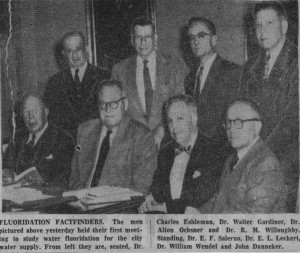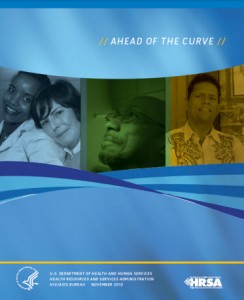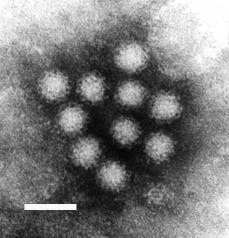
We learned from childhood that if you give a mouse a cookie heÔÇÖs going to want a glass of milk. It is lesser known, however, whether an increase in milk consumption in the general rodent population is directly caused by rampant cookie consumption among mice. Correlation does not necessarily indicate causation.?á A similar logical fallacy comes from one member of the Church of the Flying Spaghetti Monster who claims that there exists ÔÇ£a statistically significant inverse relationship between pirates and global temperature;ÔÇØ therefore, according to him, more piracy will decrease global temperature and the number of natural disasters. These examples, though silly, illustrate the importance of scientific research in drawing causation in an uncontrolled environment and in distinguishing between folklore, coincidence, and the truth.
One such truth-seeking project involves public health and is the source of long-standing controversyÔÇöthe issue: community water fluoridation (CWF). Beginning in 1954 in New Orleans, a committee of health professionals convened to address CWF. The committee consisted of several area doctors including LSU Medical CenterÔÇÖs Dr. Russell Holman, who served as Professor and Head of the Pathology Department from 1946 until his death in 1960. An article from the New Orleans Item in 1955 describes the committee as divided and unsure with the exception of Dr. Holman, who planted his support firmly on the side of fluoridation. A final decision was made in 1957 to veto CWF due to a need for further study.
Articles within the past few years on nola.com address CWF in New Orleans following Hurricane Katrina as being a lack of supply. Now it appears that fluoride has been returned to our water. A 2010 Sewage and Water Board of New Orleans report defines fluoridation as a way ÔÇ£to prevent tooth decay.ÔÇØ Later in the same report, fluoride is defined as a ÔÇ£contaminantÔÇØ: its presence on average .8ppm on the East Bank and .81ppm on the West Bank. Likely sources are listed as ÔÇ£erosion of natural deposits; water additive which promotes strong teeth; discharge from fertilizer and aluminum factories.ÔÇØ
Though the addition of fluoride to the nation’s drinking water has become common practice, the matter of its efficacy is still unresolved. In weighing the risks and benefits of CWF, the exact nature of correlation between improvements and harm to the publicÔÇÖs dental health remains unclear. Proponents of community health attempt to account for socioeconomic factors, access to dental care, pyorrhea and periodontal concerns in children and adults, as well as fluorosis, a cosmetic issue caused by over-fluoridation.
The CDC has called water fluoridation ÔÇ£one of the 10 great public health achievements of the 20th century,ÔÇØ and in 2010, the center’s statistics show the percentage of the U.S. population receiving fluoridated water at 66.2%. Perhaps we ought to take a cue from the Church of the Flying Spaghetti Monster: take to sea, forget dental care, and go marauding!
Glimpse of the Past is an ongoing project to promote the Louisiana Digital Library effort. This Month in History will present for your reading pleasure a closer look into a newspaper clipping of note from our Digital Collections and articles relating to the LSU Medical School.?á
LSUHSC is hosting a free study for adults with well-controlled asthma as part of the American Lung AssociationÔÇÖs Long-acting Beta Agonist Step-Down Study (LASST). People 18 years of age and older who have controlled asthma are encouraged to call 504-568-3450 for more information.
With the high cost of medicine, patients have been known to lower their own dosages as their health improves in order to save money. LASST seeks to study various treatment plans as a way to safely decrease dosages of asthma medication over time. Below is the description of LASST as presented on the American Lung Association website:
ÔÇ£Current asthma guidelines recommend stepping down therapy once asthma is controlled for at least three months. For patients treated with inhaled corticosteroids (ICS) alone, a dose reduction of 25ÔÇô50 percent to a minimal dose that controls disease is established. However, the optimal approach to reducing treatment in patients with asthma that is well controlled on fixed dose combination ICS/LABA (long-acting beta agonists) is not clear. The study will compare three approaches of care to patients with asthma well controlled for three months on combination ICS/LABA therapy: reduction of ICS dose and maintenance of LABA, initial discontinuation of LABA with continuation of ICS and continuation of stable dose ICS/LABA. The data will allow the determination of?áthe optimal treatment strategy?ádefined as that which results in the lowest rate of treatment failure over 48 weeks of follow up. Additional exploratory analyses will include assessing risk factors for step-down failure and assessing the optimal duration of time that asthma control should be maintained before therapy is reduced.ÔÇØ
The Centers for Disease Control have released?á2013 Vaccine Recommendations for adults. Changes include new recommendations for Pneumococcal Vaccine and Tdap/ Td Vaccines.?á There is also a simple quiz to help patients figure out what vaccines may be necessary. For more complete information, see the complete report, Advisory Committee on Immunization Practices (ACIP) Recommended Immunization Schedule for Adults Aged 19 Years and Older ÔÇö United States, 2013.
Last week, MedlinePlus, the National Library of Medicine and National Institute of Health’s consumer health database, published the top 10 most?ávisited health topic searches?áof 2012:
Looking at these searches, it would seem that the public are?ásearching for information on?áthe most common health?áthreats in the?áUnited States.?á?áAccording to the Mayo Clinic, the top seven threats to women’s health are?áheart disease, cancer, stroke, chronic lower respiratory diseases, Alzheimer’s disease, accidents, and type 2 diabetes. The top seven threats to men’s health are similar:?áheart disease, cancer, accidents, chronic lower respiratory diseases, stroke, type 2 diabetes, and suicide.
Of course the most visited sites could also mean that people who were diagnosed with high blood pressure and diabetes started exercising?ábut they had trouble breathing, had heart palpitations,?ágot sunburned, and hurt their backs!

Ahead of the Curve
The Ryan White HIV/AIDS Program Progress Report
The LSUHSC HOP Clinic was featured as a case study in the Ryan White HIV/AIDS Program Progress Report 2012(pgs 32-40). The Report is issued by the US Department of Health and Human Services – Health Resources and Services Administration – HIV/AIDS Programs.?á The many services offered by the Clinic and several faculty members are highlighted.
The Centers for Disease Control offers a monthly Public Health Grand Rounds webcast.?á The Tuesday, September 18th broadcast (12-1 pm CDT) is entitled “Explaining the Unexplained: Discovering New Diseases Using Advanced Detection Tools.“?á It is possible to receive continuing education contact hours for participating.

During World War II, Theodore Geissel (better known as Dr. Seuss) joined the war effort doing what he did best, creating cartoons and educating. He was commissioned as a captain in the US Army. The Contagions blog discovered this image on the USDA Young Dipterists website and NPR picked the story up.?á This is the first page of a handbook for soldiers to help educate them on the prevention of malaria by avoiding mosquito bites…no partying with Ann for them!
Perhaps those of us in South Louisiana should be taking his advice 70 years later with West Nile outbreaks making the news.?á Of course the Centers for Disease Control have released a feature with some more modern advice.

Book Cover
It was always exciting to go digging around in your grandparent’s attic as a kid. You never know what you might find; old photos, love letters and toys, maybe a treasure map to lost pirate gold.
Imagine if you got to dig around in all the old stuff the National Library of Medicine has laying around. Now you can catch a glimpse of their weird, wacky and wonderful collection.
Hidden Treasure: The National Library of Medicine is a beautiful and fascinating new book. Check out a New York Times review or have a look yourself. The book is available in the Isch?® Library stacks and as an EBook online from NLM.
The CDC published another feature on travel earlier this month; this time on Staying Healthy on a Cruise.?á At least this one isn’t an advisory like the ones for Spring Break or Carnival.
It recommends being up on the appropriate immunizations and vaccines and mentions precautions regarding seasickness and norovirus.
Along these travel lines, the books display at the Isché Library highlight a variety of travel topics.
NPR ran a story this morning about the troubling rise in diabetes rates in adolescents.?á According to a CDC study the rates of diabetes in youths aged 12-19 has risen alarmingly.
LSUHSC’s own Dr. Melinda Sothern commented in the story about the concerns of the high rates of diabetes in adolescent girls in particular:
These are teen girls ÔÇö adolescent girls ÔÇö who are going to become mothers in the next five to 10 years. And if their weight is not healthy, we’re going to have another generation of these children with metabolic problems that lead to diabetes and prediabetes
Obesity in children is a hot topic right now and is something that concerns all of us, not just those with children.?á A report on economic costs of diabetes states:
Approximately $1 in $10 health care dollars is attributed to diabetes. Indirect costs include increased factors such as absenteeism, reduced productivity, and lost productive capacity due to early mortality.
FYI, LSUHSC has another connection to the NPR story. The accompanying photo on NPR’s website was taken by Director of Information Services, Leslie Capo.
 As the “locavore” movement continues to blossom across the country, it’s no longer only rural citizens who have access to less-industrialized food options: even residents of cities are finding ways to grow their own produce, or at least acquire it from nearby sources. This provides more economical and healthy options for cooks. A part of this movement has been the choice of some urban homesteaders to raise their own poultry.
As the “locavore” movement continues to blossom across the country, it’s no longer only rural citizens who have access to less-industrialized food options: even residents of cities are finding ways to grow their own produce, or at least acquire it from nearby sources. This provides more economical and healthy options for cooks. A part of this movement has been the choice of some urban homesteaders to raise their own poultry.
The Centers for Disease Control & Prevention (CDC) currently has a page on its website with helpful information about Keeping Backyard Poultry. The major point that the CDC addresses is the prevention of the spread of Salmonella, an illness that is transmitted in a variety of ways. It can be spread through contact with poultry (or any birds), including?áchickens, ducks, geese, and turkeys.
Salmonellosis is an infection with the bacteria called?áSalmonella.?áMost persons infected with?áSalmonella?ádevelop diarrhea, fever, and abdominal cramps 12 to 72 hours after infection. The illness usually lasts 4 to 7 days, and most persons recover without treatment. However, in some persons, the diarrhea may be so severe that the patient needs to be hospitalized. In these patients, the?áSalmonella?áinfection may spread from the intestines to the blood stream, and then to other body sites and can cause death unless the person is treated promptly with antibiotics.

The elderly, infants, and those with impaired immune systems are more likely to have a severe illness. The CDC highly recommends hand-washing and careful hygiene to anyone handling live poultry or poultry products such as meat or eggs. All poultry and poultry-related equipment and supplies should be considered contaminated even if the animals look healthy.
Interestingly enough, the?áTimes-Picayune?ápublished an article?álast year that examined troubles with feral chicken populations which have grown since Hurricane Katrina. Recently, local ABC affiliate WGNO-TV covered a story about the difficulties in catching feral chickens in the city. New Orleans has its own special set of issues when it comes to the cosmopolitan bird.
The 2 year anniversary of the Deep Water Horizon oil spill?á(pdf) was earlier this week.?á There are a number of studies being performed to determine the long term issues relating to the spill and it’s clean up.?á
LSUHSC is a member of the Deepwater Horizon Research Consortium, a network of community and university partnerships that will conduct research on the gulf coast over the next 5 years. Specifically, the LSUHSC School of Public Health is conducting the Women and their ChildrenÔÇÖs Health (WATCH) study, which will investigate the short and long term physical, mental and community health effects resulting from the Deepwater Horizon oil spill.
Additionally, LSU Baton Rouge is involved in measuring the economic and ecological impact of the spill.

Photo Credit: F.P. Williams, U.S. EPA
Various local news agencies are reporting that the LSU baseball team was missing 16 players for their game last night due to stomach flu.
Coincidentally, the CDC is featuring Norovirus Surveillance on their webpage yesterday. We published a publication alert post in November about Norovirus in NBA players.
Much like the Carnival Advisory we wrote about last month, the Centers for Disease Control has posted a Spring Break Travel Advisory. I wonder how many Spring Breakers even know that the CDC exists?
Americans who turn up in the emergency room to get dental care aren’t lost, they’re probably just running out of options.
According to a new report from the Pew Center on the States more than 800,000 visits to the ER in 2009 were for toothaches and other avoidable dental ailments.
What effect will this have on the future of dental care??á It really depends on who you are talking to:
This is NPR’s view.
This is the ADA’s view.

 myLSUHSC
myLSUHSC





